The OSIRIS-REX mission in on a two year trajectory back to Earth after capturing fragments of the near Earth asteroid Bennu after successfully executing a sample touchdown last fall. [LINK]
The sampling of of the asteroid’s surface is shown above.
The OSIRIS-REX mission in on a two year trajectory back to Earth after capturing fragments of the near Earth asteroid Bennu after successfully executing a sample touchdown last fall. [LINK]
The sampling of of the asteroid’s surface is shown above.

Take a look at this image of Bennu and notice the material being ejected from the surface in the middle of the image. We are seeing an extremely rare “active” asteroid for the first time up-close. According to Dante Lauretta of the University of Arizona, "probably the biggest surprise of the early stages of the OSIRIS-REx mission and, I would say, one of the biggest surprises of my scientific career".
Since Osiris-Rex’s arrival in January this kind of event has been observed at least eleven times with three of events ejecting over 100 observable particles. There is no official theory as to the cause, but they suggest that these particles ultimately go into orbit for a spell and eventually return to the surface of Bennu. Which explains why after billions of years the rock hasn’t whittled away to nothing.
A near real-time movie! This is a pretty rare thing in deep space exploration. Most clips we see are time-lapse moons slipping by other moons or a spacecraft approaching it’s target. It is not often we see such dramatic movies coming from deep space.
Occator Crater is the mesa or large butte with a flat top located in the lower right hand corner of the image. It has been puzzling scientists since Dawn approached Ceres because its brightness was so intense that people were speculating if light could somehow actually be emanating from within the body. Many details are now visible in the boundaries between the bright and dark material but it is not yet clear if the lines are runoff, splatter or some other process yet to be understood.
 Still — as close as this is, the nature of these spots are unknown. Must… get… closer… Read more.
Still — as close as this is, the nature of these spots are unknown. Must… get… closer… Read more.
Especially if you have kids with an appreciation for science. These guys regularly do great animations that explain complex science — appropriate for all ages. They also promise a series of cool videos about cool moons in our solar system. So far they have only covered our own, next up… Mars’ Deimos and Phobos.
 The Dawn Spacecraft has been orbiting at Vesta for some time now. Surely some great science, but visually we are looking at an object that reminds us very much of the Martian moon Phobos. And like so many of the smaller rocky bodies of the inner solar system — up close, most images could easily pass for Apollo images of our own moon.
The Dawn Spacecraft has been orbiting at Vesta for some time now. Surely some great science, but visually we are looking at an object that reminds us very much of the Martian moon Phobos. And like so many of the smaller rocky bodies of the inner solar system — up close, most images could easily pass for Apollo images of our own moon.
However, there are some things we haven’t seen very much of on rocky surfaces like Vesta. Dark and light ejecta material reminds us more of what we see at Iapetus and Hyperion (both Saturnian moons) — which are largely moons of ice.
The grooves which nearly reach all the way around Vesta are very similar to the grooves found on Phobos (a rocky Martian moon). Many scientists believe those lines came from the cataclysmic event that formed Stickney Crater which nearly shattered the small moon, but instead left behind rippled scars as gravity pulled it all back together. Similarly, an enormous crater at the Vesta's south seems to correspond to these multiple ridges.

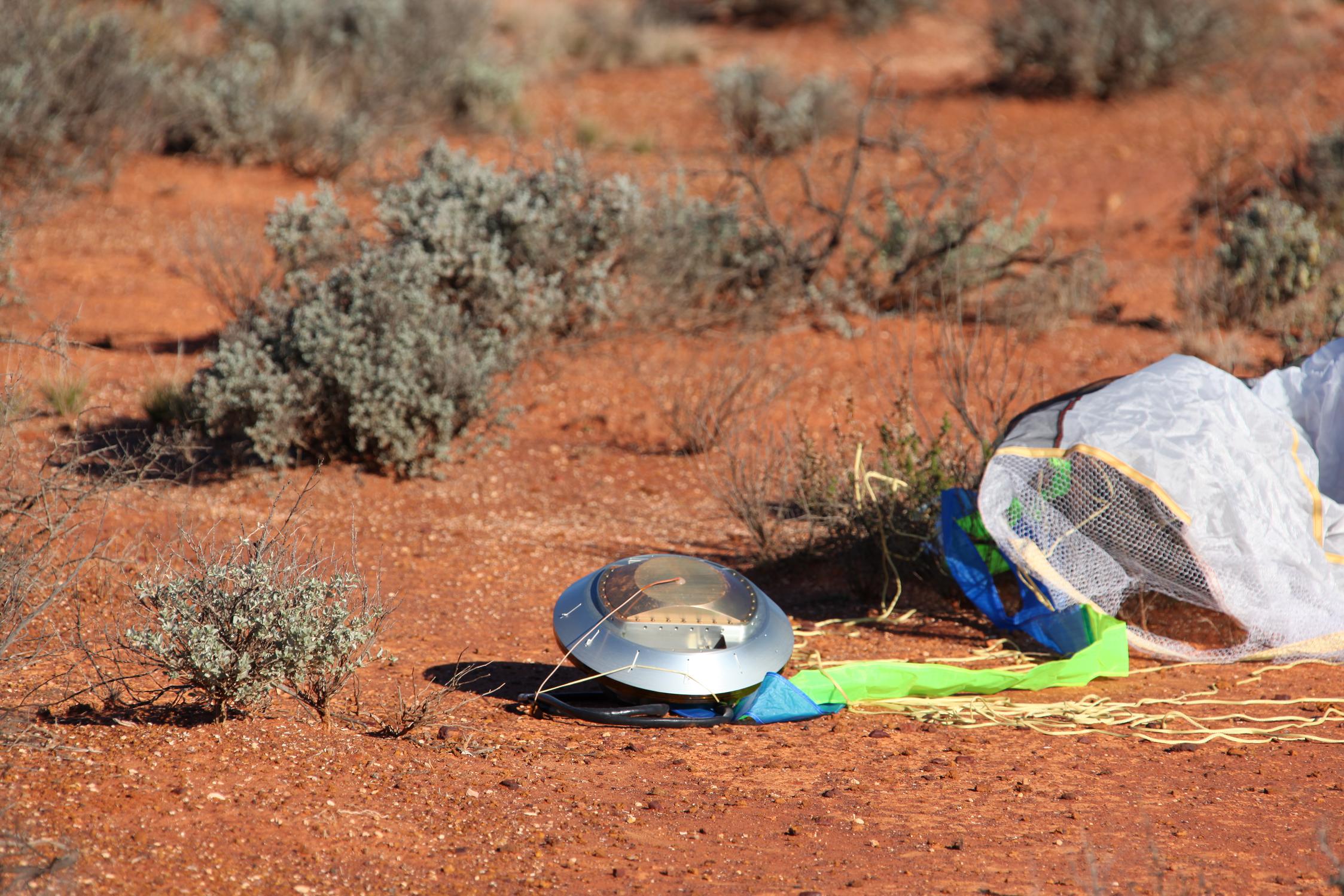 In contrast to nearly every other phase of the mission to and from Itokawa, the re-entry and landing on Earth went without a hitch. The capsule was retrieved and returned to Tokyo, where hopefully it will contain the first ever asteroid samples that did not go through the extreme heat of passing through the Earth atmosphere.
In contrast to nearly every other phase of the mission to and from Itokawa, the re-entry and landing on Earth went without a hitch. The capsule was retrieved and returned to Tokyo, where hopefully it will contain the first ever asteroid samples that did not go through the extreme heat of passing through the Earth atmosphere.
 If you Google “Hayabusa” you will likely find a few articles about a mission plagued by problems and will leave you with the impression that the engineers at JAXA are a bunch of bumbling goons. What you will find less of is the fact that a sample-return mission is just about the most difficult types of missions any organization can attempt. As a matter of fact, only 4 sample-return missions (other than Apollo) have ever been successfully executed in history. Two Lunar missions by the Soviets with Luna 20 and 24 and much later, two American lead missions Genesis and Stardust which collected space dust and cometary particles. It is worth noting also that only two of those missions actually included landing on the surface of another body, grabbing some samples and then returning home. So for JAXA to even attempt such a bold mission without having even 1% the robotic mission experience of the USA and the Russians is all by itself an accomplishment.
If you Google “Hayabusa” you will likely find a few articles about a mission plagued by problems and will leave you with the impression that the engineers at JAXA are a bunch of bumbling goons. What you will find less of is the fact that a sample-return mission is just about the most difficult types of missions any organization can attempt. As a matter of fact, only 4 sample-return missions (other than Apollo) have ever been successfully executed in history. Two Lunar missions by the Soviets with Luna 20 and 24 and much later, two American lead missions Genesis and Stardust which collected space dust and cometary particles. It is worth noting also that only two of those missions actually included landing on the surface of another body, grabbing some samples and then returning home. So for JAXA to even attempt such a bold mission without having even 1% the robotic mission experience of the USA and the Russians is all by itself an accomplishment.
So what were the failures? Well, there is a long list of issues including: a Solar Flare that destroyed solar cells aboard the craft, two reaction wheels that control movement failed, two attempts to fire pellets at the surface failed (to kick up the samples into the collection cannister) and finally a whole litany of communication errors, fuel leaks and telemetry issues which put the mission in serious doubt of ever returning to Earth. To make a long story short — the probe did touch-down on the surface of asteroid Itokowa. The first such mission ever intentionally designed to do so (NASA did have an impromptu touch down on 433 Eros in 2000, but that was more a controlled crash). Despite the pellet failures, mission specialists think that the very act of touching down was likely to kick up enough dust to collect some materials in the collection canister. After much wrangling with a seriously debilitated spacecraft they managed to get Hayabusa on make-shift trajectory back to Earth, very much later than planned… but home just the same.
With fingers crossed, the sample package is to parachute down in South Australia on or around June 13th at which point it will be shuttled back to Japan and hopefully they will find something contained within. Even if it is just a few particles, it will still be the only samples of asteroid particles un-altered by the extreme heat of a natural Earth entry (aka: a meteor) and only the 3rd time in history a probe landed on another world and returned a piece of it back to Earth for study. Not bad for the new kids in space.
Pictured at top is a frame from the trailer “Hayabusa Back to Earth” in anticipation of the potentially successful sample-return mission. It appears to be a 3-D render based on actual images returned from the mission. The second is an actual image with the shadow of the spacecraft as it maneuvered to a close encounter with its target. The third image illustrates what touch-down may have been like for Hayabusa. You can see the large amount of theoretical dust kicked up by the thrusters which may be JAXA’s best hope for actually having captured particles in the sample-return canister.
 What NASA thinks we might be looking at here is an asteroid that was recently shattered by another asteroid, giving it a comet-like appearance. It stays within the asteroid belt, so it cannot be a comet as those objects are known to be dusty ice-balls that stay in highly elliptical orbits around the Sun.
What NASA thinks we might be looking at here is an asteroid that was recently shattered by another asteroid, giving it a comet-like appearance. It stays within the asteroid belt, so it cannot be a comet as those objects are known to be dusty ice-balls that stay in highly elliptical orbits around the Sun.
 This is so nice, but I am furious that I didn’t get to design this. This is Information design at it’s best naturally by National Geographic. You can see 50 years of robotic planetary exploration at a glance. It even includes failed missions represented by darker desaturated lines. As far as I can tell the cream colored lines are US and the red ones are Soviet. Interesting to see how many of those lines go dark around Mars.
This is so nice, but I am furious that I didn’t get to design this. This is Information design at it’s best naturally by National Geographic. You can see 50 years of robotic planetary exploration at a glance. It even includes failed missions represented by darker desaturated lines. As far as I can tell the cream colored lines are US and the red ones are Soviet. Interesting to see how many of those lines go dark around Mars.
Now where does one purchase such a thing? Perhaps this month’s issue of NG? Here is the link to it on their site complete with zoom viewer and them some kind samaritan posted a hires version to flickr.
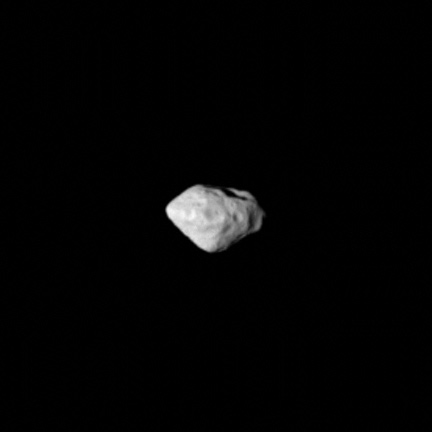 Asteroid Steins seen from a distance of around 800 km by Rosetta. This tiny asteroid is only around 5 km at it’s largest dimension with a crater on the top right that is approximately 1.5-km in size. That is a large impact for such a tiny body, but we have seen small bodies survive such large impacts before (Phobos, moon of Mars for instance). It seems like a pretty typical asteroid thus far and joins the growing family of such bodies visited by we humans. As a matter of fact, if I didn’t know where this came from — I would have assumed it was just another tiny moonlet imaged by Cassini in orbit around Saturn.
Asteroid Steins seen from a distance of around 800 km by Rosetta. This tiny asteroid is only around 5 km at it’s largest dimension with a crater on the top right that is approximately 1.5-km in size. That is a large impact for such a tiny body, but we have seen small bodies survive such large impacts before (Phobos, moon of Mars for instance). It seems like a pretty typical asteroid thus far and joins the growing family of such bodies visited by we humans. As a matter of fact, if I didn’t know where this came from — I would have assumed it was just another tiny moonlet imaged by Cassini in orbit around Saturn.
See the flyby animation on the official ESA Rosetta site. For those keeping score… the next major encounter in our Solar System is in just about a month with another Messenger visit to Mercury.
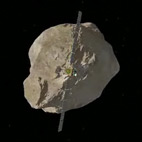 Steins, a rare E-type asteroid, is going to have company tomorrow as Rosetta swings by on its long voyage to Comet 67P/Churyumov-Gerasimenko scheduled to occur in 2014. See a quick computer simulation of tomorrow’s encounter here.
The encounter is to take place on Sept 5 with data and images to be communicated back to Earth that evening. Processing of that information is to take place on the 6th along with a press conference. Chances are, images and other information will not become public until that conference is underway as ESA still likes to roll things out the old fashioned way.
Steins, a rare E-type asteroid, is going to have company tomorrow as Rosetta swings by on its long voyage to Comet 67P/Churyumov-Gerasimenko scheduled to occur in 2014. See a quick computer simulation of tomorrow’s encounter here.
The encounter is to take place on Sept 5 with data and images to be communicated back to Earth that evening. Processing of that information is to take place on the 6th along with a press conference. Chances are, images and other information will not become public until that conference is underway as ESA still likes to roll things out the old fashioned way.
 Just in time for Valentine’s Day… a ménage à tous! Aricebo captured this radar image of asteroid 2001SN263 which turned out to be a triple asteroid. This is the first near-Earth object found to have more than one moonlet. Is it just me or does that main asteroid seem orb-like?
Just in time for Valentine’s Day… a ménage à tous! Aricebo captured this radar image of asteroid 2001SN263 which turned out to be a triple asteroid. This is the first near-Earth object found to have more than one moonlet. Is it just me or does that main asteroid seem orb-like?
 Cassini takes a pass at Titan on February 22 (already having made a pass this year on January 5th).
Cassini takes a pass at Titan on February 22 (already having made a pass this year on January 5th).

Soon after Titan, Cassini performs a truly unexpected maneuver and flies directly through the plumes of Enceladus on March 12th. This is a somewhat risky task for the probe as the particles it will surely encounter may pose some kind of impact threat to the spacecraft. Mission planners expect the risk to be low as they intend to turn the spacecraft around and let the less delicate side of Cassini bear the brunt of the material and photograph the geysers as it moves away from Enceladus. It should make for some of the most exciting planetary science planned for this year.

Cassini has another go at Titan on March 25.

Yup – you guessed it. Cassini at Titan again on May 12th.
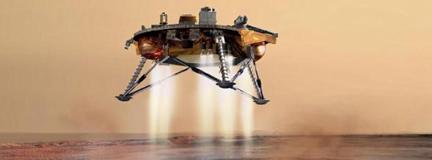
The Phoenix lander arrives at Mars on May 25th and (hopefully) makes good on the failure of the Mars Polar Lander. It will be the first time a probe will attempt a landing on the Martian pole and will conduct a series of experiments looking for the existence of water ice.

You can never have too much of a good thing. Cassini at Titan again on May 28th as well as July 31.
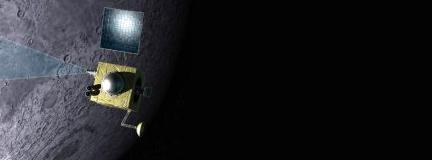
Chandrayaan becomes India’s first planetary probe as it leaves for the moon in Early July (was April).

The extended Cassini mission has made Enceladus a prime target of investigation and the new encounters begin on Aug 11th and comes within 54km of the surface.

Rosetta still on its way for an encounter with Comet 67P/Churyumov-Gerasimenko in 2014, will make a close pass at an asteroid named 2867 Steins on Sept 5th at a distance of only 1700 km. Steins is a small asteroid measuring only a few kilometers in size and the craft will be traveling at a relatively slow speed which should allow for some good resolution images to be acquired during the encounter.

Messenger (having just completed the first encounter in 33 years this past week) has another go at Mercury on Oct 6th and flies past more uncharted territory on its way to eventual orbit insertion in 2011.

Two more close flybys of the Saturnian moon Enceladus on Oct 9 and Oct 31. The first at hair-raising distance of 25km and the second around a more reasonable 200km.
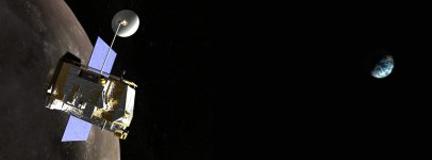
In an effort to recognize the International Lunar Decade (and intended manned Lunar missions within 15 years), the United States returns to the moon with the Lunar Reconnaissance Orbiter on Nov 3rd. It is expected to begin its scientific goals only 3 days after launch and is expected to look for possible deposits of water ice in permanently shadowed craters near the Lunar poles.

And finally more Titan flybys on Nov 3, Nov 19, Dec 5 and Dec 21.
All this is in addition to the ongoing work of Opportunity and Spirit on the surface of Mars. Mars Express and Mars Reconnaissance in orbit around Mars. Cassini’s non-targeted continuing tour of other icy Saturnian moons. And who knows, maybe we will see more than 2 or 3 reports coming from the ever quiet Venus Express mission currently at Venus.
Sadly, some very exciting missions will be quietly traveling en route to their targets and are not expected to be heard from in 08 like the Dawn Mission to the Asteroid Belt, New Horizons mission to Pluto/Charon, the newly re-targeted Deep Impact mission (now known as Epoxi) as well as Stardust now on its way to a follow-up visit to Tempel 1 the comet that was smacked by Deep Impact in 2005.
The Dawn mission to the 2 largest asteroids in our Solar System was supposed to have been launched this week, but has been postponed until September of this same year. Apparently due to Dawn’s repeated launching schedule delays it could have interrupted the launching schedule for the Mars Pheonix lander which has a less flexible launch window.

The above images are the best taken thus far of both objects by the Hubble Space Telescope (images not to scale). Vesta appears to be similar to most objects of its type with one exception... We most likely have samples of this body here on Earth as meteorites. It seems the composition of a bunch of meteors known as HED class meteors match that of observations made of Vesta. The theory is that at some point a huge impact took place on Vesta which shattered it into many fragments. Some of these Vesta originating fragments are orbiting the sun in the Asteroid belt to this day while smaller bits of this collision were thrown inward toward the sun (likely through disturbances coming from Jupiter) and some wound up landing here on Earth as meteors. If this turns out to be true, then Vesta would be one of only 5 bodies that we currently have confirmed samples of. Those additional bodies being our own moon, Mars (also through a similar natural meteoric process), Wild 2 and Earth itself.
Ceres on the other hand is the largest Asteroid in the Solar System and for a few days was considered a planet in 2006 until the definition of “planet” was fine tuned a few days later to exclude not only Ceres, but famously Pluto as well. However, an upgrade was in order and Ceres is now officially a Dwarf Planet as it maintains its own spherical shape, orbits the Sun and is not itself a moon of any other body. More interesting than its definitive status in the Solar System is the fact that it is relatively warm, may have a tenuous atmosphere and frost on the surface. Some surface features have also raised many questions about the nature of Ceres such as the dark spot that was imaged in 95 and later disappeared. Then there is the recently observed white spot which has no theoretical identity at all. Hopefully, this may mean that in 2015 we may discover that Ceres is not just another heavily cratered inactive grey body in our Solar System but another enigmatic body like Io and Enceladus that defies preconceived notions of what to expect. Who knows what processes might cause Ceres to be active on any level, but surely we have been surprised before.
 Itokawa (full name 25143 Itokawa) is an Earth crossing type asteroid that was visited by JAXA (Japan Aerospace Exploration Agency) in 2005. It was, and still may be, the first asteroid to be sampled and returned to Earth. To make a long story short, JAXA attempted quite a complicated mission for such a young agency and sent a probe to Itokawa. The plan was for Hayabusa to orbit, land upon, sample a bit of the surface and then return those samples back to Earth for retrieval. Currently, the mission is seriously damaged and operating on 1 of 3 reaction wheels. Additionally, Hayabusa suffered a major solar flare that damaged several battery cells, a rehearsal landing failed, the agency is unsure if any samples actually made it into the return cannister and 2 probes designed to study the surface also failed. Despite all this trouble and serious concern about its ability to even make it back to Earth… in early 2007 Hayabusa began its long questionable trip back home. Should it make it, the sample return cannister should re-enter Earth atmosphere in 2010.
Itokawa (full name 25143 Itokawa) is an Earth crossing type asteroid that was visited by JAXA (Japan Aerospace Exploration Agency) in 2005. It was, and still may be, the first asteroid to be sampled and returned to Earth. To make a long story short, JAXA attempted quite a complicated mission for such a young agency and sent a probe to Itokawa. The plan was for Hayabusa to orbit, land upon, sample a bit of the surface and then return those samples back to Earth for retrieval. Currently, the mission is seriously damaged and operating on 1 of 3 reaction wheels. Additionally, Hayabusa suffered a major solar flare that damaged several battery cells, a rehearsal landing failed, the agency is unsure if any samples actually made it into the return cannister and 2 probes designed to study the surface also failed. Despite all this trouble and serious concern about its ability to even make it back to Earth… in early 2007 Hayabusa began its long questionable trip back home. Should it make it, the sample return cannister should re-enter Earth atmosphere in 2010.
Never surrender!